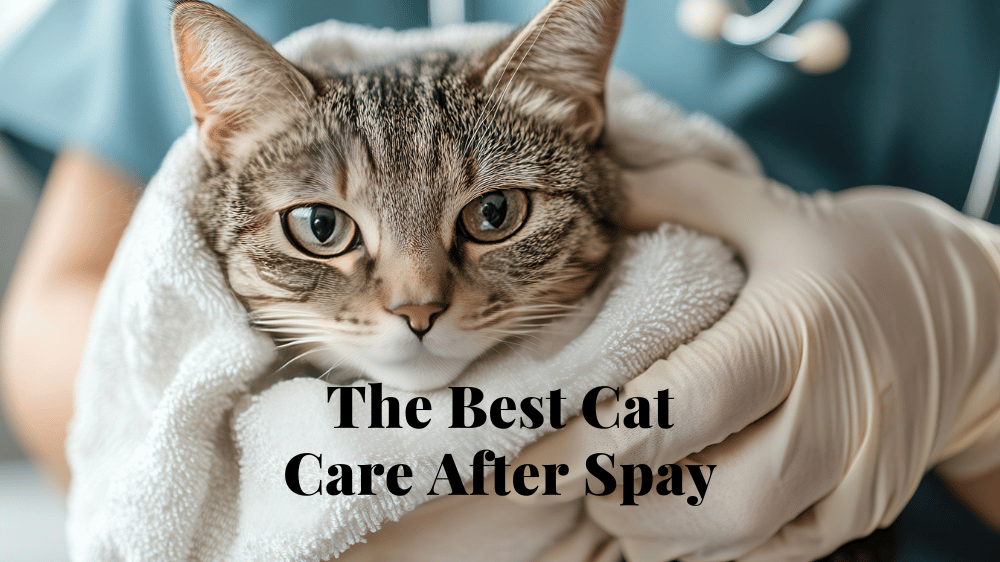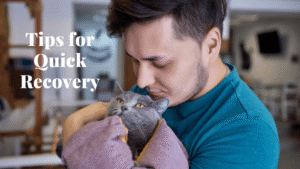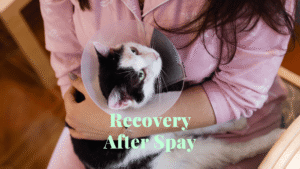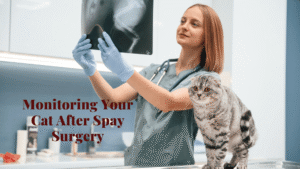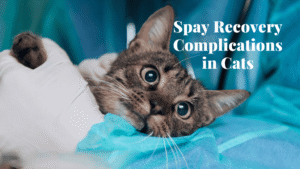Regarding “cat care after spay,” knowledge about the recovering process is essential to making sure your cat gets well soon. Commonly known as ovariohysterectomy, spaying a cat is a routine surgical operation that involves the removal of the cat’s ovaries and uterus and offers many health benefits as well as preventing unwelcome litters. But post-op care is crucial to a successful recovery and to preventing issues.
What to Expect During Cat Spay Recovery
Your kitty will presumably be groggy from the anesthesia after the surgery. It’s essential to allow her to recover in a calm quiet environment. A cat’s spay recovery time will typically last around two weeks, although it can depend on the cat and how well she reacts to the post spay care.
First, cat pain management after spay is important, and your veterinarian may prescribe pain medication to help with discomfort.
Table: Timeline of Cat Recovery After Spay
| Recovery Phase | What to Expect | Care Tips |
| First 24 Hours | Grogginess, limited movement | Keep your cat calm, monitor for signs of pain |
| 1 Week | Slight swelling, discomfort may persist | Keep the area clean, limit activity |
| 2-3 Weeks | Full recovery expected | Gradually return to regular activities |
Key Cat Care After Spay: Tips for Quick Recovery
Appropriate “cat care after spay” can accelerate the recovery process and lessen the chance of complications. Here are some cat aftercare tips to observe:
- Limit Activity: The first step you should take is to limit your cat’s activity during the “Spay recovery for cats”. This includes no jumping, running, or rough play for at least two weeks. This helps to keep the incision line from opening (dehiscence) or other potential problems such as bleeding or infection.
- Incision Care: Take note of the incision to see if there is any infection. “Spayed cat healing” might just be some swelling and bruising that usually goes away in a couple of days. If there is any redness, discharge, or odor, take your cat to the vet right away.
- Monitor for Complications: Just be extra careful watching your cat after the spay procedure. After-effects such as severe swelling, problems breathing, or behavior changes should also be treated immediately. Things go wrong in relation to spay recovery issues in cats; they just don’t go wrong very often — but they can, and it always pays to know the signs.
Spayed Cat Healing Process: What to Expect
The spayed cat healing process is different with each cat. Some of them may heal more quickly than others, while some of them may take longer to recover. You’ll have some swelling at the incision site for about a week. The swelling will gradually subside, but continued swelling over a large area would warrant a vet visit to rule out infection.
Note that when we say cat care during spay recovery, that also means letting your cat rest. Restrict her contact with loud sounds, other animals, and small children, which might be stressful and hinder healing.
How to Help a Cat Recover After Spay Surgery
There are many considerations about How to help a cat recover after spay surgery apart from simply restricting activity and how to monitor the incision etc. You want to make sure your cat is eating and drinking.
Give a little bit of water and a few bites of food after the surgery so as not to make the dog nauseous. As she becomes interested in eating, slowly reintroduce her regular diet.
It’s also important to give your cat a comfortable bed and a clean litter box. Transition to using fresh litter types, including recycled paper or non-clumping, to prevent irritation around the incision site.
Spayed Cat Healing Tips: Best Practices for Post-Surgery Care
But, when all is said and done, you can do things to help your kitty heal faster and prevent problems by following these spayed cat healing tips. Ensure the cat is wearing a recovery collar or surgical suit.
These will prevent your cat from licking or biting the incision, which can become infected or cause the wound to open. Your cat may hate the collar, but it is a crucial tool for keeping the surgical area safe.
Provide your cat with the prescribed pain medications after the spay. It’s also very important for “cat care after spay” to give your cat the pain medications provided by your veterinarian.
These are necessary in controlling and minimizing any pain and inflammation that may occur after the surgery. Cat pain management after spay later results when you spay your cat as it will feel comfortable and rest well in the recovery and during the recovery.
Cat Spay Recovery Time: How Long Does It Take?
The average cat spay recovery time generally takes about 10-14 days, and should be completely healed by then. But it is worth mentioning that some cats may recover more slowly, particularly if there are any complications as part of the surgery.
For the next few days, your cat will also probably be sleepy and less activity, which is normal as she recovers from anesthesia. It is important to let her rest a lot in this time.
You should begin to see your cat’s energy levels becoming more consistent as she heals. The process of spay recovery for cats doesn’t happen all at once so you will need to be patient and keep a watchful eye out for any signs of pain or strange behavior.
Monitoring Your Cat After Spay Surgery: Key Considerations
Taking care of a cat after spaying
Taking care of a cat after spaying is a crucial part of making sure your cat recovered uneventfully. Daily, inspect the wound for signs of infection. Look out for the following:
- Discoloration: It’s natural to have swelling and redness around the incision; however, it should not advance beyond the surrounding area.
- Discharge: Some clear (or possibly slightly pinkish in color) discharge is normal in the first 24-48 hours. But if you see any kind of pus or notice any kind of bad odor emanating from them, get him to a vet right away.
- Excessive Licking or Chewing: If your cat is licking your cat’s own incision, make sure to try a “recovery collar” such as Kong Cloud Collar to prevent this.
You can also monitor your cat’s general behavior. If she’s overly lethargic, won’t eat, won’t drink, or seems painful and doesn’t respond to medication, then it’s time to call your vet.
Cat Spay Surgery Aftercare: Final Tips for a Smooth Recovery
Proper cat spay surgery aftercare is essential to the recovery of your furry friend. In addition to good care (ensuring your cat is resting and not engaging in too much activity, and keeping an eye on the incision), here are some things to remember:
- Avoid Bathing: Refrain from bathing your cat while the wound is healing, as doing so may get the incision wet and potentially introduce bacteria to the incision. If need be, just wipe her down with a damp cloth.
- Limit Social Interaction: Minimize socializing. Keep other pets separate from your cat during its recovery. This provides her a space to physically rest and heal.
- Comfort and Support: Provide your cat a quiet, comfortable place to lay. A quiet and clean environment: To minimize stress and encourage healing.
Spay Recovery Complications in Cats: When to Seek Veterinary Help
Though spay recovery complications in cats are not common, it’s essential to understand when it’s time to reach out to your vet for help. The signs that suggest you’re dealing with a complication include:
- Extreme bulging of the skin in or around the incision that does not fade over days..
- Ongoing vomiting or diarrhea, particularly if your cat is not taking in solids or fluids.
- A large amount of bleeding or signs of infection, including a bad-smelling discharge from the incision.
- Difficulty urinating or having a bowel movement after having surgery, which could be a sign of a urinary tract infection or other problems.
If any of these signs manifest do not wait, call your vet.
Conclusion: Ensuring a Successful Cat Care After Spay
Follow these tips, and you can be assured that you are taking very good care of your cat, not only before but after her spay operation.
“Cat care after spay” is essential to a fast and healthy recovery. By the use of these instructions and being in tune with your pets needs for “spayed cat recovery, you can help to prevent complications and side her in getting back to her regular routine. Make sure to keep her environment calm, and give her healing and pain management medications as needed.
With patience and proper care, your cat will soon be back to her roly-poly self. For any strange symptoms or concerns, always check with your vet for advice. Your cat is at the mercy of the quality and time you invest in this important recuperation period.
Frequently Asked Questions (FAQs)
-
Can I leave my cat alone after being spayed?
No, you shouldn’t leave your cat alone, at least during the first 24 hours after spaying. Cat care after spay is the careful observation that is needed during this period when your cat could still be groggy from the anesthesia. She requires a peaceful, secure place to rest and recover. Following that initial 24 hours, she can be left by herself for short amounts of time, always in a place that is safe for her and where she can’t harm herself, including in the area of the incision.
-
How do I keep my cat from licking the incision after spaying?
An important part of spayed cat healing tips is to make sure your cat doesn’t lick or chew the incision. You can do this by placing a recovery collar (otherwise known as an “Elizabethan collar”) on her to stop her from getting to the surgical site. A soft recovery suit, or inflatable doughnut collar, also can be helpful. Preventing your cat from licking the incision is key in order to avoid infections or other problems after a “spay recovery for cats”. -
How long does it take for my cat to fully recover after being spayed?
In an ordinary cat spay recovery time is in the 10-14 day range. Observable “cat care after spay” in this time will be essentially rest and control of movement with a close eye on the incision to check for infection. Most cats are well in about 2 weeks and are able to return to their usual activities. But you’ll still want to keep an eye on the area for any changes as every cat spaying recovery is unique. -
Is it normal for my cat to have some swelling after spaying?
Yes, some swelling in the area of the incision is to be expected during the Spayed cat healing process. This should only last a few days. But if the swelling doesn’t go away or gets worse, or you see increased redness or discharge, it may be a sign of infection. If you have a case of suspected spay complications – then do get in touch with your vet to avoid any possible issues cropping up in your cat’s “spay recovery period”.
-
What should I do if I notice unusual symptoms, like excessive bleeding or discharge from the incision?
If you observe abnormal symptoms like too much bleeding or bad odor from the incision, then it can be complications of cat spay surgery aftercare. And it is crucial to speak to your vet as soon as possible to rule out any kind of infection or other problems. By identifying the condition early, conservative treatment may prevent more serious problems with the cat spay recovery time.
-
How should I manage my cat’s diet after spaying?
Be careful feeding your cat during “cat care after spay” during the first 24-48 hours following spay. Provide her with small portions of water and food to prevent nausea, as a certain number of cats have a slight upset stomach caused by the anesthesia. Once she has an appetite, slowly wean her onto regular feed. Do not give the cat any human food and supplementary products – this may adversely affect them, and it’s one of the main spayed cat healing tips.
-
When can I allow my cat to return to normal activities?
After your cat’s Spay recovery for cats it usually varies on what your veterinarian/mother cat dictates, but your cat can go about its normal activities again after 2-3 weeks (Read how long does it take for a cat to recover from spaying). From now on don’t let her jump, run or do any rough playing because that also can cause the incision to heal incorrectly or have problems. What I want to emphasize is the necessity of a cat care following spay surgery routine.

